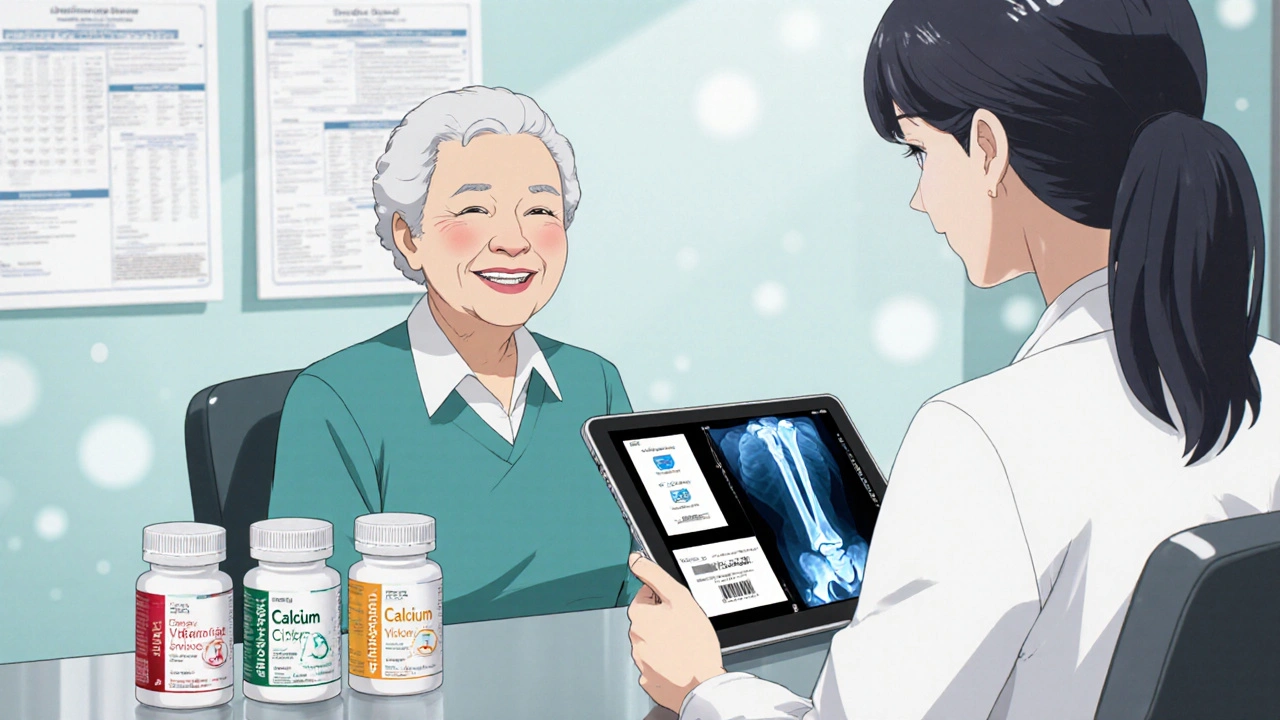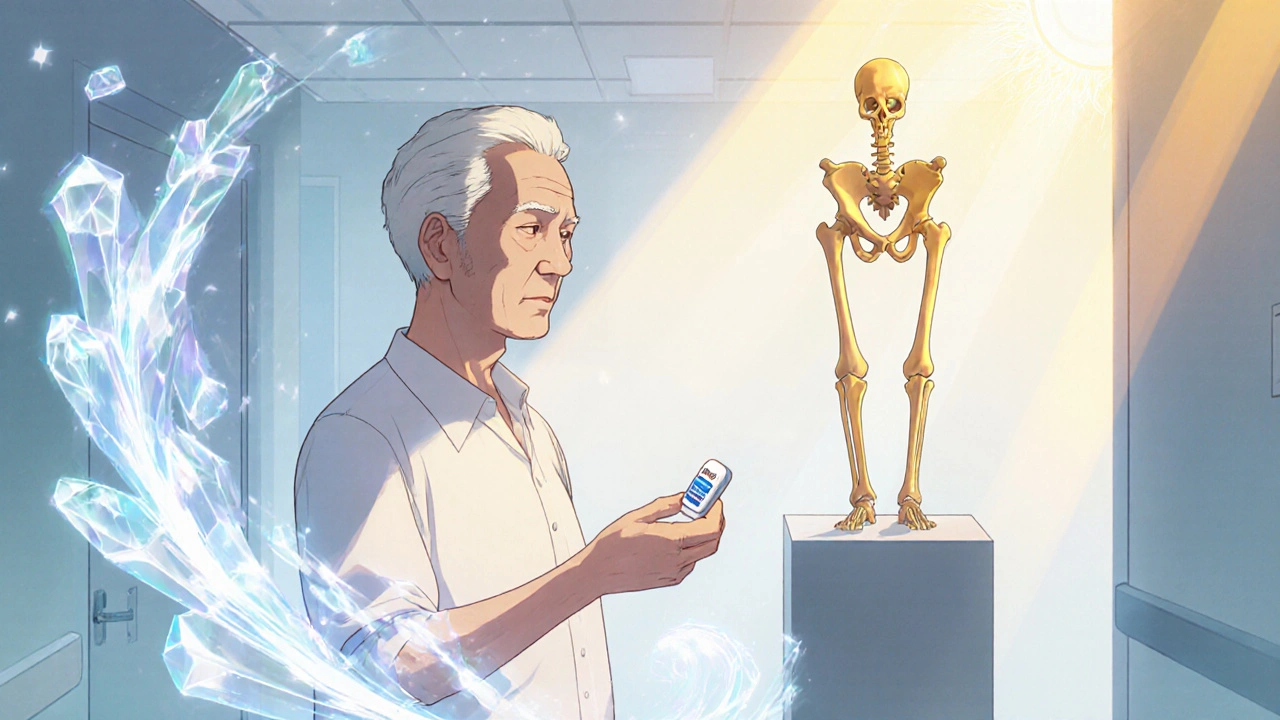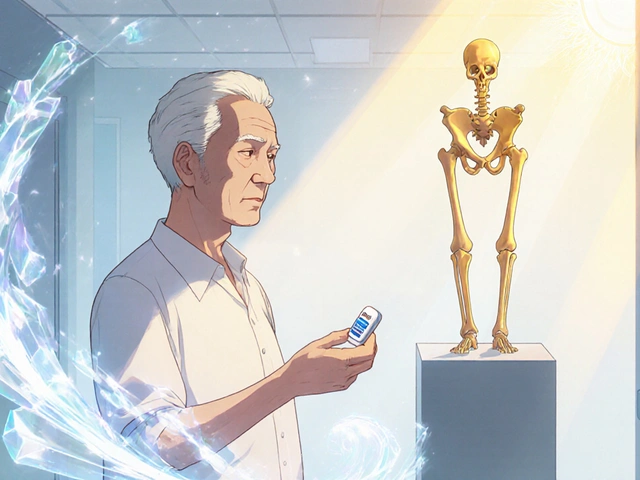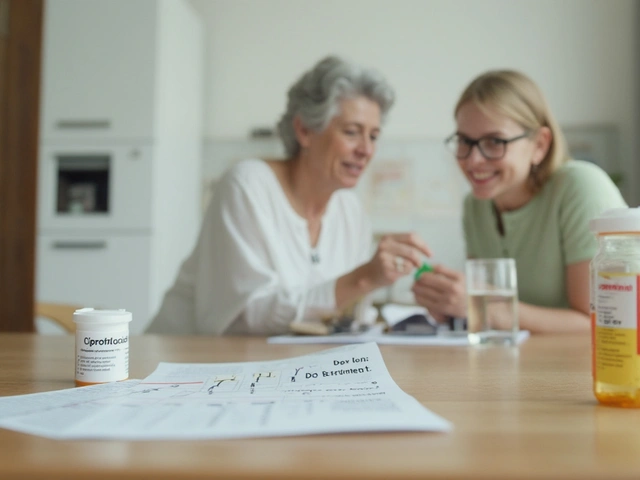Calcium and Vitamin D Daily Intake Calculator
Calculate Your Daily Needs
This calculator helps you determine how much calcium and vitamin D you should be getting daily while taking alendronate for osteoporosis.
Important: Your doctor should determine your specific requirements based on your health condition. This tool provides general guidelines.
Did you know that up to 30% of people on osteoporosis medication develop low blood calcium if they skip their supplements? That’s why the tiny minerals calcium and vitamin D become the unsung heroes when you’re prescribed Alendronate.
What Is Alendronate and How Does It Work?
Alendronate is a bisphosphonate drug that binds to bone surfaces and inhibits osteoclast‑mediated bone resorption, effectively slowing the loss of bone density. Doctors often choose it because it’s taken once a week or once a month, making adherence easier than daily pills.
The drug’s action hinges on a delicate balance of calcium in the bloodstream. When bone breakdown slows, calcium that would normally be released into the blood stays locked in bone, potentially lowering serum calcium levels.
Why Calcium Can’t Be Overlooked
Calcium is the primary building block of bone. Adults need about 1,000 mg daily, but the amount jumps to 1,200 mg for women over 50 and men over 70. If you’re on alendronate, reaching that target becomes even more critical because the medication makes the body rely on external calcium sources.
Insufficient calcium while taking alendronate can trigger hypocalcemia - a condition marked by muscle cramps, tingling sensations, and in severe cases, cardiac arrhythmias. The risk is higher for people with kidney disease, because their kidneys struggle to convert vitamin D into its active form, further limiting calcium absorption.
Vitamin D: The Absorption Booster
Vitamin D doesn’t build bone directly, but it tells the intestines to pull calcium from the food you eat. The recommended daily intake varies: 600 IU for adults up to age 70, and 800 IU after that. In Australia, sunlight provides a natural source, yet many Australians still fall short, especially during winter months.
When vitamin D levels dip, even a perfect calcium diet won’t translate into strong bones. The synergy between calcium and vitamin D is why clinicians pair them with alendronate in standard osteoporosis protocols.

How to Time Your Supplements with Alendronate
- Take alendronate first thing in the morning with a full glass of plain water. Do NOT eat or drink anything else for at least 30 minutes.
- After the 30‑minute window, enjoy a calcium‑rich breakfast-think fortified cereal, low‑fat yogurt, or a glass of orange juice with added calcium.
- Follow the meal with your vitamin D supplement. If you use a combined calcium‑vitamin D tablet, take it after the meal as well.
- Stay upright for at least 30 minutes after taking alendronate to reduce the chance of esophageal irritation.
This sequence keeps the medication’s absorption optimal while ensuring calcium and vitamin D get the digestive environment they need.
Choosing the Right Calcium and Vitamin D Products
| Form | Calcium (mg per dose) | Vitamin D (IU per dose) | Best Use Case |
|---|---|---|---|
| Calcium carbonate + Vitamin D3 | 500 | 400 | When you eat a meal with some fat (helps absorption) |
| Calcium citrate + Vitamin D3 | 250 | 400 | For people with low stomach acid or who take meds on an empty stomach |
| Standalone Vitamin D3 | 0 | 800 | Winter months or limited sun exposure |
Calcium carbonate delivers more calcium per tablet but needs stomach acid to dissolve. Calcium citrate is gentler on the gut and can be taken anytime, which is handy if you miss a meal.
Monitoring and Safety Checks
Before starting alendronate, doctors usually order a blood panel that includes serum calcium, phosphate, and 25‑hydroxy vitamin D. Repeat testing after three months helps catch any deficiency early.
If you notice symptoms like persistent muscle cramps, numbness around the mouth, or a racing heart, contact your clinician right away. These could signal low calcium, and a simple supplement adjustment often resolves the issue.
Patients with severe kidney impairment (eGFR < 30 mL/min) may need lower calcium doses or an alternative osteoporosis drug, because their kidneys can’t activate vitamin D efficiently.

Common Pitfalls and How to Avoid Them
- Skipping supplements. It’s easy to forget a pill after a busy morning. Set a phone reminder right after you’ve taken alendronate.
- Taking calcium at the same time as alendronate. Calcium binds to alendronate and blocks its absorption, rendering the medication ineffective.
- Relying on diet alone. Even a dairy‑rich diet may fall short of the 1,200 mg target for seniors.
- Over‑supplementing. Excess calcium can increase the risk of kidney stones. Stick to the recommended dosage unless your doctor advises otherwise.
By planning your supplement schedule, you protect both your bone health and the effectiveness of alendronate.
Bottom Line: Pairing is Power
Alendronate does a great job of slowing bone loss, but it leans on calcium and vitamin D to keep the body’s mineral balance stable. Ignoring those nutrients can lead to low blood calcium, side‑effects, and a reduced benefit from the medication. The simple habit of taking a calcium and vitamin D supplement at the right time each day can make the difference between a stable bone density scan and a worrying decline.
Frequently Asked Questions
Can I take calcium carbonate and alendronate together?
No. Calcium binds to alendronate in the stomach and prevents it from being absorbed. Take alendronate first, wait 30 minutes, then have your calcium.
What vitamin D dose is safe while on alendronate?
For most adults, 800 IU daily is sufficient. People with very low baseline levels may need up to 2,000 IU, but only under medical supervision.
How often should I get my blood levels checked?
A baseline test before starting alendronate, then a follow‑up at three months. After that, an annual check is typical unless symptoms arise.
Is it okay to take a multivitamin that includes calcium?
Yes, as long as the total calcium from diet, multivitamin, and any extra supplement doesn’t exceed 1,200 mg per day for seniors. Keep track to avoid excess.
What foods are rich in calcium and vitamin D?
Calcium: fortified plant milks, low‑fat yogurt, cheese, sardines with bones, leafy greens. Vitamin D: oily fish (salmon, mackerel), egg yolks, fortified cereals, and safe sun exposure for 10‑15 minutes daily.









Comments
I learned the hard way that skipping calcium after taking alendronate can leave you feeling like a walking electrolyte deficit, and the moment I missed my supplement for three days, my muscles started cramping in the night, not only did the tingling spread to my fingertips, but I also experienced an unsettling sense of heart palpitations that forced me to call my doctor; the lab work confirmed a dip in serum calcium, my physician reminded me that alendronate locks calcium into bone, without an external source, the bloodstream inevitably depletes, this is precisely why the timing protocol matters: take the bisphosphonate with plain water on an empty stomach, wait the full thirty minutes before consuming any calcium‑containing food or beverage, then follow with a calcium‑rich breakfast, ideally pair it with vitamin D to boost intestinal absorption, the vitamin also facilitates the conversion of calcium into its active form, for those with reduced gastric acidity, calcium citrate is a gentler alternative to carbonate, however, even citrate still requires the same temporal separation from alendronate, in summary, consistency in supplement scheduling is not a mere suggestion, but a critical component of the therapeutic regimen.
We get tangled in supplement schedules like it’s some grand conspiracy, but at the end of the day the body just wants basic minerals, and alendronate does its job only if you give it the raw material it needs, so a simple glass of water followed by a calcium‑vitamin D combo isn’t rocket science, it’s just common sense, and if you’re feeling lazy, set a reminder on your phone and you’ll be fine.
Actually, the whole hype around calcium pills is a circus, and anyone who thinks you can drown alendronate in a milkshake is missing the point, the drug needs an empty stomach to stick to bone, not to get glued to calcium, so ignore the “take everything together” crowd, and trust the science that says separation is key, otherwise you’re just pouring money down the drain.
Let’s break down the pharmacokinetic window: alendronate has low oral bioavailability, roughly 0.6%, and its binding affinity to hydroxyapatite spikes when the gastric pH is neutral, which is why you must swallow it with plain water and remain upright for thirty minutes, after that interval, introduce calcium carbonate or citrate to replenish serum levels, and supplement with vitamin D3 (800 IU) to upregulate calbindin expression in the enterocytes, this coordinated regimen maximizes anti‑resorptive efficacy while minimizing hypocalcemia risk.
As anyone who has spent years dissecting bone metabolism can attest, the timing you described is not optional, it’s the gold standard, and if you deviate, you’re courting suboptimal outcomes, so follow the protocol to the minute, and the results will speak for themselves.
Don’t you dare dismiss the supplement schedule as a circus, because ignoring the calcium‑vitamin D timing can land you with serious hypocalcemia, muscle cramps, and even cardiac arrhythmias, the stakes are high, and the science is clear.
Bottom line: respect the window or suffer the consequences.
Listen-if you pop alendronate and then chug a calcium shake immediately-your body says “nope”!! you gotta wait, at least half an hour, then you can indulge-no excuses.
Good point about consistency. It really does matter.
Adherence influences pharmacodynamics; delayed calcium ingestion alters osteoclast inhibition kinetics, leading to subtherapeutic serum concentrations.
Calcium shiz literally saves your butt!